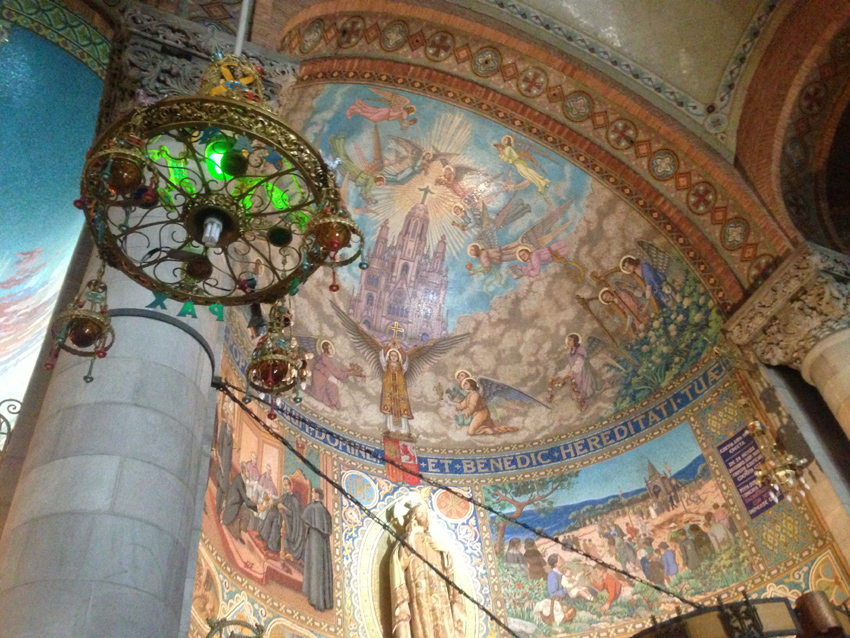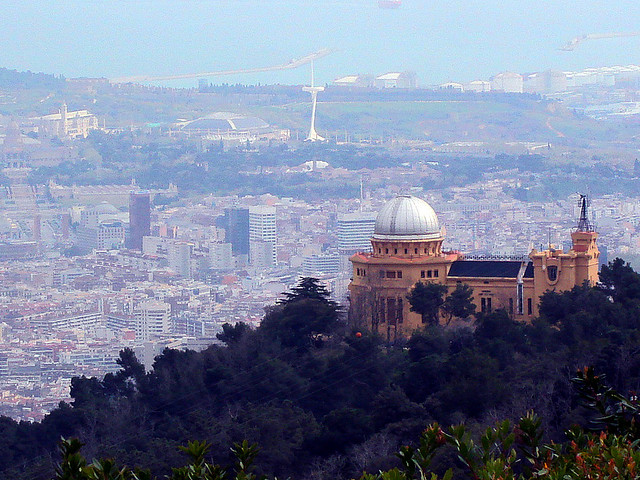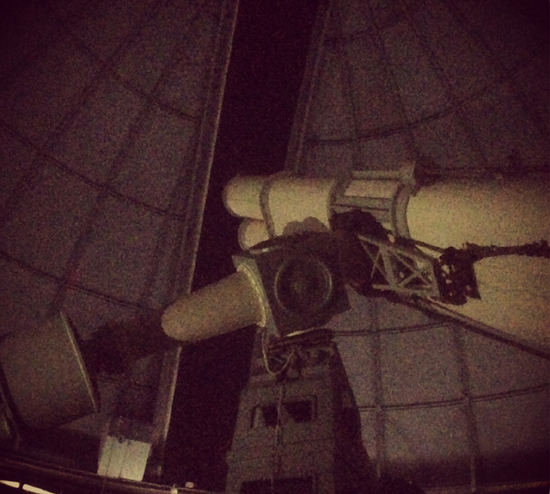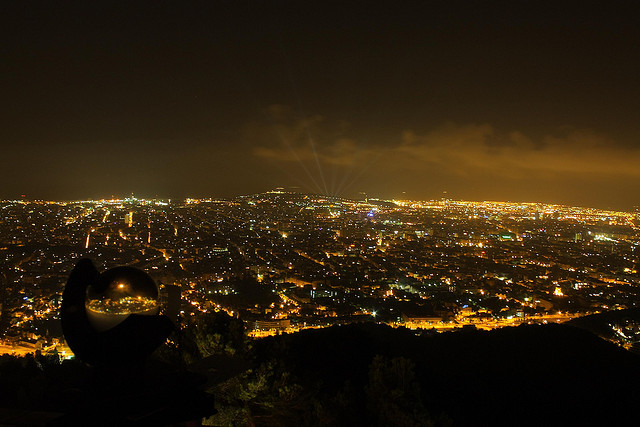Mount Tibidabo is fast becoming my favourite place in Barcelona.
It’s a slow burner, granted. I’d lived here two full years before even setting foot on a single funicular to ferry me up to its pine-clad slopes, up, up and away from the anything-but-bucolic Barcelona below.
And once you peak, chances are your head is turned by the exigencies of expiation. The screams from the funfair’s roller coaster (they must be atoning for something), or the beguilingly beautiful lanterns of the summit-smug Sagrat Cor church.

Admit it, you’re beguiled.
But all the while, right under your nose – and indeed, in most postcards of Tibidabo – is a century-old site that most Barcelonans themselves have never discovered.
The fabulous Fabra Observatory.

Perched among pine trees at over 400 metres above sea level, the Observatory was originally conceived of as a site devoted not just to the study of astronomy, but of meteorology and seismology.
In fact, dating from 1904, it’s one of the most ancient bases of astronomical, meteorological and seismological study in the world.
The first team of staff took up their posts in April 1906 (it had taken two years to recruit them – bear in mind, the guide points out, there was no InfoJobs back then). And they didn’t mess about. A good 29 years before the Richter Scale was even introduced, the Barcelona team’s instruments predicted major seismic activity on the other side of the world.
Sure enough, on April 18, 1906, the devastation of the 1906 San Francisco earthquake was unleashed.

“The universe knew we were coming.”
The universe might have known we were coming, but I’m betting it hadn’t bargained on us coming by public transport.
The Observatory’s website helpfully counsels “we recommend you come by car”. Sadly lacking in the car department, I somewhat trepidatiously eyed up the public transport options. This involved a metro ride from Tarragona to Plaça Catalunya (20 minutes), then a connecting train from Plaça Catalunya to Peu de Funicular (15 minutes – make sure you sit in a middle carriage or you’ll alight straight onto a brick wall), then the funicular train from Peu de Funicular right up to Vallvidrera Superior.
Exiting the station, in the middle of nowhere up a mountain, I consulted the bus timetable from Vallvidrera, only to find out I had a good 25-minute wait in store. In what was probably not the wisest decision of my life (iPhone in handbag), I decided sod it, what’s a dark mountain top between friends on a Saturday night, and hiked it up the hill on foot till I reached the Observatory, pausing now and again to gasp in awe at the Sagrat Cor church lit up, up close. (The church is honestly spectacular, and well worth the trip.)
Reaching the Observatory, at last, it turned out I was 45 minutes early. Ushering me through the gates, the guide was magnanimous in the face of my quaintly British tendencies.
“Why don’t you wait at the look-out point?”, he suggested, as I nodded and obligingly circumnavigated the building in the dark.
Alone, early, feeling irksomely non-Spanish, I found myself stumbling towards a long bench of decking, flanked by trees, and then gasping at the sudden view of the whole Barcelona conurbation corruscating at my feet.

The photos, of course, don’t do it justice.
To the left stood the Torre Agbar, in all its contentious conflagrations. In the middle the W Hotel, punctuating the horizon, definitively marking the end of the beach. A little inland, the reasurringly blue rays beamed over MNAC, the Magic Fountain dancing and prancing in symmetrical synchronicity, commanding attention, the prettiest belle of the ville.
I thought of James Joyce and his epiphanies.
Half an hour later, I found myself, not for the first time in the last two and a half years, the only non-Catalan-speaking person in the room. The guide seemed a kind, friendly little man, who clearly knew his stuff. He quickly clocked the look of dismay/incomprehension/boredom on my face as he launched into his welcome speech to the audience, which I was surprised to see on a Saturday night were mostly made up of parents and young kids.
“I’m just going to switch into Spanish”, he smiled at everyone, much to my gratitude.

Owned by the Royal Academy of Sciences and Arts of Barcelona, the southward-facing Observatory has an illustrious history. It’s the fourth-oldest observatory in the world that’s still going strong, and the building itself is the brainchild of reluctantly Modernista architect Josep Domenech i Estapà (the same designer behind the likes of CosmoCaixa and the city’s Law Courts).
The Observatory’s scientists began keeping records in 1914, and our guide takes pains to point out that not one day of data over the last 99 years – on the local weather, regional seismic activity and celestial shenanigans – has gone unrecorded. (He also mentions that this October has been the warmest since records began, confirming my deeply-held Scottish suspicions.)
Poignantly, this uninterrupted track record comes despite the devastation of the city during the Spanish Civil War. The Observatory then became a makeshift refugee camp for some members of the Royal Academy of Sciences and Arts, and the systematic bombing of Barcelona from its viewing deck must have been a terrible sight to behold.
The dame in the dome – the Fabra Telescope
Holding court in the Observatory’s cupula, the telescope itself is a grand old dame. One of the largest and oldest telescopes in Europe, it loomed large in front of us as we climbed the narrow access ladder, momentarily silencing the overweening Spanish children.
Each person got to take their turn, for about 20 seconds, to eye up the in-focus planets. On clear nights, our guide explains, they zoom in on the moon, but on overcast evenings the planets provide a more satisfying voyeuristic experience.

Did the earth move for you?
I have to admit, what I saw through the lens wasn’t earth-shattering.
It could best be described as a nebulous white blob.
Later on, the young Spanish mother who I’d met in the museum and who had very kindly offered me a lift back down the mountain confessed to a similar sense of bemusement.
“What did you see?” she quizzed me as her husband took the Tibidabo bends expertly. “A white blob?” I ventured, and the three of us laughed in relief.

Similarly starstruck?

The Observatory is open to the public on Sundays from 11am to 12.30pm, and you’re fine to just show up without booking ahead (note that it’s closed all throughout August, though).
For night-time visits (and let’s face it, that’s what it comes into its own), you’ll pay a bargain 10€ entry fee for a welcome speech (in Spanish), followed by on-eyeball planet action through the telescope, and a stroll around the panoramic outdoor walkway.
Feel like splashing out? Or just hungry? From June till September each year the Observatory offers ‘Sopars amb estrelles’ (‘dinner under the stars’), where you get to dine in what must be one of the most privileged places in Barcelona. It’s not cheap (and I can’t vouch for the food), but having seen the look-out point/terrace where the supper takes place, I bet you’re in for a treat. Book ahead.
Whenever you go, bear in mind that Tibidabo tends to get a little on the frigid side (relatively speaking – I’m from Glasgow), and you’d be as well to bring a cardigan or light jacket for when that wind really starts to nip.


GuiriGirlinBarca is written by native Scot Julie Sheridan, who left Edinburgh’s haar-stricken hills for the slightly sunnier shores of Barcelona in April 2011. Armed with a big red emigrating suitcase (called La Roja) she arrived in the Catalan capital without knowing a soul, or indeed any Catalan. Her blog is an honest account of the ups and downs of life abroad as a single woman, including now not to get stalked by men and how to avoid unfortunate incidents with hamsters on bank holidays.








